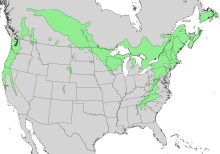Beak hazel
| Beak hazel | ||||||||||||
|---|---|---|---|---|---|---|---|---|---|---|---|---|

Leaves and nuts |
||||||||||||
| Systematics | ||||||||||||
|
||||||||||||
| Scientific name | ||||||||||||
| Corylus cornuta | ||||||||||||
| Marshall |
The beaked hazel or beak nut ( Corylus cornuta ) is a shrub or tree from the birch family . It is found in Canada and the USA .
description
The beak hazel is one to 4 to 8, rarely up to 15 meters high shrub or tree with light to dark brown, smooth bark and softly hairy branches. The winter buds of the flowers are egg-shaped, 3 to 5 millimeters long, 3 to 4 millimeters wide and pointed. The leaves have a 0.6 to 1.2 cm long, glabrous, hairy or glandular hairy stalk. The leaf blade is 4 to 10 centimeters long and 3.5 to 12 centimeters wide, ovate to obovate, pointed or rounded with a heart-shaped base and a finely serrate and barely lobed leaf margin. The underside of the leaf is softly hairy. The male inflorescences are arranged in groups of two to three, 4 to 6 centimeters long and 0.5 to 0.8 centimeters in diameter catkins with 0.5 to 10 millimeter long stalks and yellow stamens. The nuts grow in groups of two to six. They are 1.2 to 1.8 centimeters long and surrounded by a downy, hairy shell that is contracted over the nut to form a 3 to 4 centimeter long tube ("beak").
The number of chromosomes is 2n = 22.
Distribution and location
The distribution area extends over large parts of Canada and the USA. There it grows in cool, moist forests or bushes on well-drained, fresh to moist, moderately nutrient-rich, sandy to gravelly humus or loamy soils in sunny to light-shaded, cool summer and winter cold locations. The species is frost hardy.
Systematics
The beaked hazel ( Corylus cornuta ) is a kind of the genus of hazel ( Corylus ) in the family of birch family (Betulaceae). It is assigned to the Corylus section , Siphonochlamys subsection . It was first described by Humphry Marshall in 1785 .
There are two subspecies:
- Corylus cornuta subsp. cornuta with egg-shaped to almost elliptical leaf blades, twigs without glandular hairs and a beak at least twice the length of the nut. It is found in Canada and the northern and eastern United States.
- Corylus cornuta subsp. californica (A.DC.) AEMurray with almost round or broadly elliptical leaf blades, twigs with glandular hairs and a shorter beak. The occurrence of the subspecies extends along the Pacific coast of North America from British Columbia to California.
use
The beak hazel is rarely used for forestry purposes. It is used as an ornamental plant because of its fruits and also serves as a bee pasture . The nuts are edible, but of no economic importance. Parts of the plant were used by the Indians as emetics and against worm infestation.
proof
literature
- Andreas Roloff , Andreas Bärtels: Flora of the woods. Purpose, properties and use. With a winter key from Bernd Schulz. 3rd, corrected edition. Eugen Ulmer, Stuttgart (Hohenheim) 2008, ISBN 978-3-8001-5614-6 , p. 223.
- Steve Cafferty : Cosmos Atlas Trees of the World . Franckh-Kosmos, Stuttgart 2008, ISBN 978-3-440-10983-0 , p. 138 .
Individual evidence
- ^ German name after Steve Cafferty: Kosmos-Atlas trees of the world
- ↑ German name after Roloff et al .: Flora of the woods
- ↑ a b c Roloff et al .: Flora of the Woods , p. 223
- ↑ a b c Corylus cornuta. In: Flora of North America Vol. 3. www.eFloras.org, accessed January 29, 2012 (English).
- ↑ Corylus cornuta at Tropicos.org. In: IPCN Chromosome Reports . Missouri Botanical Garden, St. Louis
- ↑ Corylus cornuta. In: Germplasm Resources Information Network (GRIN). United States Department of Agriculture, accessed January 29, 2012 .
- ↑ a b Rafaël Govaerts (Ed.): Corylus. In: World Checklist of Selected Plant Families (WCSP) - The Board of Trustees of the Royal Botanic Gardens, Kew . Retrieved January 12, 2017.
- ↑ Cafferty: Kosmos-Atlas Trees of the World , p. 138


